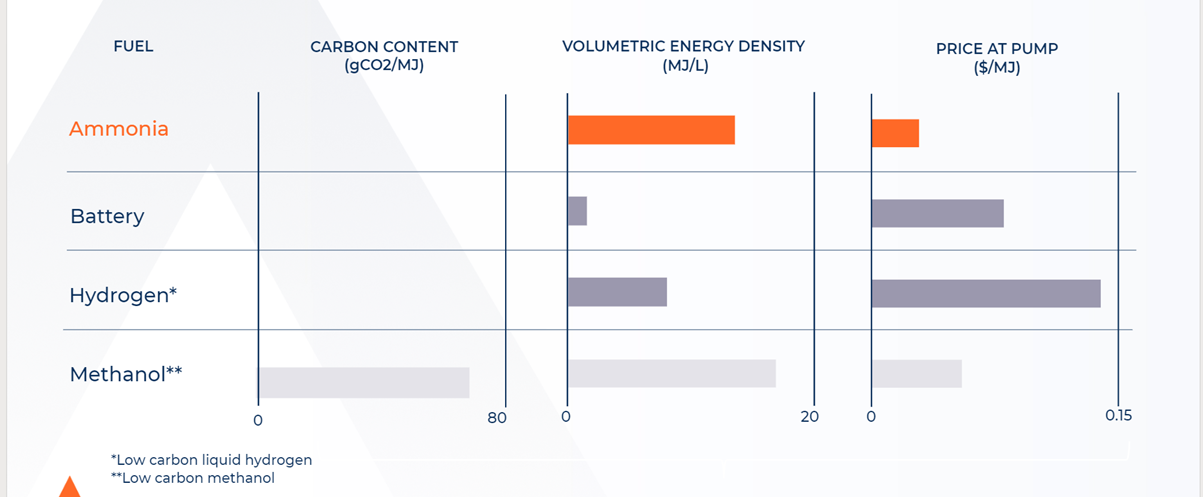Regulatory, political, and market pressures surrounding the reduction of greenhouse gas (GHG) emissions are intensifying. In the last few months alone, COP28 has seen 200 governments commit to tripling renewable energy by 2030, and the International Energy Agency (IEA) warns that annual spending on renewable energy must reach an eye-watering $4.5 trillion within the same timeframe if global warming is to be limited to 1.5 °C. Meanwhile, the International Maritime Organization (IMO) recently revised its IMO Strategy to strive for more ambitious goals like a 30% reduction in international shipping emissions by 2030 and an 80% one by 2040.
For heavy industries like maritime and power generation, the need to curb emissions has never been higher. When it comes to tackling an increasingly complex climate equation, most decision-makers are looking in one direction—hydrogen. More than a thousand large-scale hydrogen projects have already been announced, amounting to a staggering $320 billion investment. By 2050, hydrogen could contribute to a 20% reduction in global emissions. The potential of this powerful—and plentiful—element is impossible to ignore, but there are challenges to overcome before it can be fully realized.
What’s holding hydrogen back?
Hydrogen is energy-dense, making it perfect for heavy industries, and is completely emission-free when produced from renewable sources. It’s also the most abundant chemical in our universe, making up approximately 75% of its elemental mass. But things start to get complicated when we bring things back down to earth, where hydrogen in its pure form is not readily available. Instead, it’s usually bound to other elements like oxygen in water and nitrogen in ammonia.
Separating hydrogen from other elements requires energy-intensive processes like steam methane reforming (SMR) and electrolysis. Depending on whether renewable or non-renewable energy is used, these processes are often emission-intensive too.
Once extracted, storing pure hydrogen is expensive and requires a lot of energy to pressurize or refrigerate. It’s also highly flammable, colorless, odorless, and near-invisible when burning, making it difficult to detect in the event of a leak or fire. All this, combined with a lack of existing infrastructure such as suitable ports and pipelines to support a global supply chain, makes transporting and storing hydrogen at scale very difficult.
Substantial public and private investment is needed to make the hydrogen economy work, leading to increased focus on the potential of hydrogen carriers like ammonia and methanol.
Finding the perfect carrier
A truly viable hydrogen carrier needs to be emission-free, energy-dense, and cost-effective. Methanol is an energy-dense liquid, making for a versatile fuel that is easier to transport than hydrogen. Unfortunately, it contains carbon and releases carbon dioxide when burned. For methanol to be a viable green fuel, it must be produced with non-fossil fuel feedstocks—either biomass or e-methanol. The former is limited in how sustainably it can be sourced, while the latter requires a supply of carbon dioxide. That supply can be extracted directly from the air, but this process is both costly and energy-intensive, and the technology required is still in the early stages of development.
What about ammonia?
Ammonia has 2.7 times the energy density of compressed hydrogen, can be easily stored as a liquid, and requires significantly less energy to store and transport safely. Unlike methanol, hydrogen can be captured from ammonia cracking without releasing carbon—the only byproducts are water and nitrogen. As investment in blue and green ammonia increases, a future where hydrogen-derived fuel is supported by a zero-carbon supply chain is not just possible, but likely.
Ammonia is also the world’s second-most-produced chemical and is used extensively as an agricultural fertilizer across the globe. As such, more than a century’s worth of infrastructure already exists. That includes 200+ ports and 500+ vessels equipped to handle ammonia worldwide, and 4,000km+ of pipelines in the U.S. alone. The associated cost benefits of not having to build new infrastructure is a clear advantage for ammonia vs. hydrogen.
When it comes to safety, ammonia is also far less flammable than hydrogen and, in the event of a leak, is much easier to detect thanks to its strong and distinctive odor.
Ammonia vs. hydrogen and other fuels

“There will be no climate solution without hydrogen, but bypassing the inherent infrastructural challenges of transporting and storing it requires a suitable carrier. At Amogy, we believe ammonia is that carrier, combining energy density and zero carbon content, with over a hundred years of infrastructure waiting to be used.” Poornima Natarajan, Senior R&D Strategy Analyst, Amogy.
At Amogy, we’re developing power systems capable of delivering on the promise of hydrogen by making ammonia as a fuel possible, helping industries like maritime and power generation reach their Net Zero 2050 targets.
Read more about ammonia as an essential energy carrier in our white paper.